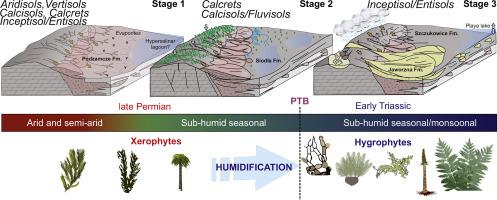当前位置:
X-MOL 学术
›
Palaeogeogr. Palaeoclimatol. Palaeoecol.
›
论文详情
Our official English website, www.x-mol.net, welcomes your
feedback! (Note: you will need to create a separate account there.)
Sedimentary and pedogenic record of seasonal humidity during the Permian-Triassic transition on the SE margin of Central European Basin (Holy Cross Mountains, Poland)
Palaeogeography, Palaeoclimatology, Palaeoecology ( IF 2.6 ) Pub Date : 2021-02-01 , DOI: 10.1016/j.palaeo.2020.110154 Karol Jewuła , Wiesław Trela , Anna Fijałkowska-Mader
Palaeogeography, Palaeoclimatology, Palaeoecology ( IF 2.6 ) Pub Date : 2021-02-01 , DOI: 10.1016/j.palaeo.2020.110154 Karol Jewuła , Wiesław Trela , Anna Fijałkowska-Mader

|
Abstract The transition from the late Permian to Early Triassic was associated with one of the biggest biotic crises in the entire Phanerozoic which affected life in both marine and continental settings. Unlike in the marine realm, the environmental dynamics in continental palaeoenvironments across the Permian-Triassic interval are still poorly understood. In order to fill this knowledge gap, we studied the Permo-Triassic continental succession from the SE part of the intracontinental Central European Basin (CEB). High-resolution sedimentological logging of over 1700 m of cores, supplemented by micromorphology of palaeosols, palynofacies, and quantitative spore-pollen analyses, allowed reconstructing major steps in palaeoenvironmental evolution, and assessing the magnitude of extrinsic factors responsible for such development. The studied interval is dominated by redbeds deposited in arid, semi-arid, and sub-humid subenvironments in which palaeosol profiles are important elements of facies architecture. Vertical and lateral facies arrangement indicate three major development stages associated with progradation of a large distributary fluvial system towards the centre of the basin. These stages correspond to the main lithostratigraphic units in the studied area. In the first stage, the saline mudflats were replaced by muddy floodplain facies and then by medial and proximal parts of the ephemeral fluvial system of the Podzamcze Formation. The overlying Siodla Formation represents the stage of environmental stabilisation associated with widespread pedogenesis resulting in the formation of thick cumulative palaeosol profiles. The last stage was marked by the influx of coarse-grained fluvial sediments of the Jaworzna Formation and change in soil character towards less evolved types in overbank facies of the Szczukowice Formation. The change in the sedimentary record and soil types reflects the successive humidification in the SE part of the CEB, supported by increasing contribution of the hygrophytic over mostly xerophytic palynomorphs in the upper Permian palynological assemblage. This humidification trend was likely an environmental response to global warming in the late Permian.
中文翻译:

中欧盆地东南缘二叠纪-三叠纪过渡期间季节性湿度的沉积和成土记录(波兰圣十字山脉)
摘要 从晚二叠世到早三叠世的过渡与整个显生宙中最大的生物危机之一有关,它影响了海洋和大陆环境中的生命。与海洋领域不同,二叠纪-三叠纪时期大陆古环境中的环境动力学仍然知之甚少。为了填补这一知识空白,我们研究了大陆内中欧盆地 (CEB) 东南部的二叠纪-三叠纪大陆序列。对超过 1700 米岩心的高分辨率沉积学记录,辅以古土壤的微形态学、孢粉相和定量孢粉分析,可以重建古环境演化的主要步骤,并评估导致这种发展的外在因素的大小。研究的层段主要是沉积在干旱、半干旱和半湿润亚环境中的红层,其中古土壤剖面是相结构的重要元素。垂直和横向相排列表明与大型分流河流系统向盆地中心进积相关的三个主要发展阶段。这些阶段对应于研究区域的主要岩石地层单元。在第一阶段,盐渍泥滩被泥质泛滥平原相取代,然后被Podzamcze 组短暂河流系统的内侧和近端部分取代。上覆的 Siodla 组代表了与广泛的成土作用相关的环境稳定阶段,导致形成厚厚的累积古土壤剖面。最后一个阶段的标志是 Jaworzna 组粗粒河流沉积物的流入,以及 Szczukowice 组河堤相中土壤特征向低演化类型的变化。沉积记录和土壤类型的变化反映了 CEB 东南部的连续增湿,这得到了上二叠纪孢粉组合中湿植物对主要旱生孢粉的贡献增加的支持。这种加湿趋势很可能是二叠纪晚期全球变暖的环境反应。在二叠纪上部孢粉组合中,湿植物对主要旱生孢粉的贡献越来越大。这种加湿趋势很可能是二叠纪晚期全球变暖的环境反应。在二叠纪上部孢粉组合中,湿植物对主要旱生孢粉的贡献越来越大。这种加湿趋势很可能是二叠纪晚期全球变暖的环境反应。
更新日期:2021-02-01
中文翻译:

中欧盆地东南缘二叠纪-三叠纪过渡期间季节性湿度的沉积和成土记录(波兰圣十字山脉)
摘要 从晚二叠世到早三叠世的过渡与整个显生宙中最大的生物危机之一有关,它影响了海洋和大陆环境中的生命。与海洋领域不同,二叠纪-三叠纪时期大陆古环境中的环境动力学仍然知之甚少。为了填补这一知识空白,我们研究了大陆内中欧盆地 (CEB) 东南部的二叠纪-三叠纪大陆序列。对超过 1700 米岩心的高分辨率沉积学记录,辅以古土壤的微形态学、孢粉相和定量孢粉分析,可以重建古环境演化的主要步骤,并评估导致这种发展的外在因素的大小。研究的层段主要是沉积在干旱、半干旱和半湿润亚环境中的红层,其中古土壤剖面是相结构的重要元素。垂直和横向相排列表明与大型分流河流系统向盆地中心进积相关的三个主要发展阶段。这些阶段对应于研究区域的主要岩石地层单元。在第一阶段,盐渍泥滩被泥质泛滥平原相取代,然后被Podzamcze 组短暂河流系统的内侧和近端部分取代。上覆的 Siodla 组代表了与广泛的成土作用相关的环境稳定阶段,导致形成厚厚的累积古土壤剖面。最后一个阶段的标志是 Jaworzna 组粗粒河流沉积物的流入,以及 Szczukowice 组河堤相中土壤特征向低演化类型的变化。沉积记录和土壤类型的变化反映了 CEB 东南部的连续增湿,这得到了上二叠纪孢粉组合中湿植物对主要旱生孢粉的贡献增加的支持。这种加湿趋势很可能是二叠纪晚期全球变暖的环境反应。在二叠纪上部孢粉组合中,湿植物对主要旱生孢粉的贡献越来越大。这种加湿趋势很可能是二叠纪晚期全球变暖的环境反应。在二叠纪上部孢粉组合中,湿植物对主要旱生孢粉的贡献越来越大。这种加湿趋势很可能是二叠纪晚期全球变暖的环境反应。











































 京公网安备 11010802027423号
京公网安备 11010802027423号